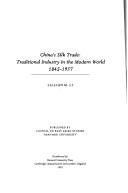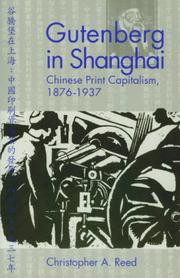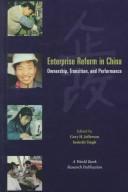| Listing 1 - 10 of 10 |
Sort by
|

ISBN: 0674119622 1684172314 Year: 1981 Publisher: Cambridge Council on East Asian Studies, Harvard University
Abstract | Keywords | Export | Availability | Bookmark
 Loading...
Loading...Choose an application
- Reference Manager
- EndNote
- RefWorks (Direct export to RefWorks)
S10/0500 --- S10/0620 --- Silk industry --- -#SML: Joseph Spae --- Silk manufacture and trade --- Textile industry --- China: Economics, industry and commerce--Industries and industrialization: general and before 1911 (economic aspects come here) --- China: Economics, industry and commerce--Foreign trade and economic relations: 1842 - 1949 --- History --- #SML: Joseph Spae --- S17/1300 --- China: Art and archaeology--Textile, tapestries, embroideries, rugs, fashion --- History. --- Silk industry.
Book
ISBN: 9781438456881 9781438456874 9781438456898 1438456891 1438456875 Year: 2015 Publisher: Albany, NY
Abstract | Keywords | Export | Availability | Bookmark
 Loading...
Loading...Choose an application
- Reference Manager
- EndNote
- RefWorks (Direct export to RefWorks)
Jeff Hornibrook provides a unique, microcosmic look at the process of industrialization in one Chinese community at the turn of the twentieth century. Industrialization came late to China, but was ultimately embraced and hastened to aid the state's strategic and military interests. In Pingxiang County in the highlands of Jiangxi Province, coalmining was seasonal work; peasants rented mines from lineage leaders to work after the harvest. These traditions changed in 1896 when the court decided that the county's mines were essential for industrialization. Foreign engineers and Chinese officials arrived to establish the new social and economic order required for mechanized mining, one that would change things for people from all levels of society. The outsiders constructed a Westernized factory town that sat uneasily within the existing community. Mistreatment of the local population, including the forced purchase of gentry-held properties and the integration of peasants into factory-style labor schemes, sparked a series of rebellions that wounded the empire and tore at the fabric of the community. Using stories found in memoirs of elite Chinese and foreign engineers, correspondence between gentry and powerful officials, travelogues of American missionaries and engineers, as well as other sources, Hornibrook offers a fascinating history of the social and political effects of industrialization in Pingxiang County.
S03/0615 --- S10/0500 --- China: Geography, description and travel--Jiangxi --- China: Economics, industry and commerce--Industries and industrialization: general and before 1911 (economic aspects come here) --- Coal mines and mining --- Industrialization --- Industrial development --- Economic development --- Economic policy --- Deindustrialization --- Coal mining --- Collieries --- Energy industries --- Mines and mineral resources --- History --- Pingxiang (Jiangxi Sheng, China) --- Dingsiang (Jiangxi Sheng, China) --- 萍乡 (Jiangxi Sheng, China) --- Economic conditions --- Social conditions
Book
ISBN: 0300216718 9780300216714 9780300196795 0300196792 Year: 2015 Publisher: New Haven
Abstract | Keywords | Export | Availability | Bookmark
 Loading...
Loading...Choose an application
- Reference Manager
- EndNote
- RefWorks (Direct export to RefWorks)
A natural resource strategist investigates the growing global demand for rare metals and what it means to the environment and our future Our future hinges on a set of elements that few of us have even heard of. In this surprising and revealing book, David S. Abraham unveils what rare metals are and why our electronic gadgets, the most powerful armies, and indeed the fate of our planet depend on them. These metals have become the building blocks of modern society; their properties are now essential for nearly all our electronic, military, and "green" technologies. But their growing use is not without environmental, economic, and geopolitical consequences. Abraham traces these elements' hidden paths from mines to our living rooms, from the remote hills of China to the frozen Gulf of Finland, providing vivid accounts of those who produce, trade, and rely on rare metals. He argues that these materials are increasingly playing a significant role in global affairs, conferring strength to countries and companies that can ensure sustainable supplies. Just as oil, iron, and bronze revolutionized previous eras, so too will these metals. The challenges this book reveals, and the plans it proposes, make it essential reading for our rare metal age.
Rare earth metals. --- Rare earth industry. --- Rare earths industry --- Nonferrous metal industries --- Lanthanide series --- Lanthanides --- Lanthanoid series --- Lanthanons --- Rare earth elements --- Nonferrous metals --- Rare earth industry --- Rare earth metals --- E-books --- S10/0523 --- S10/0500 --- China: Economics, industry and commerce--Power supply (electricity, mining, oil) and computing industry --- China: Economics, industry and commerce--Industries and industrialization: general and before 1911 (economic aspects come here)

ISBN: 082482833X Year: 2004 Publisher: Honolulu University of Hawaii press
Abstract | Keywords | Export | Availability | Bookmark
 Loading...
Loading...Choose an application
- Reference Manager
- EndNote
- RefWorks (Direct export to RefWorks)
Book industries and trade --- Printing industry --- Publishers and publishing --- Livres --- Industries graphiques --- Editeurs et édition --- History --- Industrie --- Histoire --- 655.4 <51> --- S01/0600 --- S10/0500 --- S10/0510 --- Publishing and bookselling in general--China --- China: Bibliography and reference--Books, printing, editing and paper --- China: Economics, industry and commerce--Industries and industrialization: general and before 1911 (economic aspects come here) --- China: Economics, industry and commerce--Industry: 1911 - 1949 --- Editeurs et édition
Book
ISBN: 9780300243734 Year: 2020 Publisher: New Haven, Conn. Yale University Press
Abstract | Keywords | Export | Availability | Bookmark
 Loading...
Loading...Choose an application
- Reference Manager
- EndNote
- RefWorks (Direct export to RefWorks)
"Tea War studies the competition between the tea industries of China and colonial India as an exploration of the history of capitalism. Liu challenges previous histories premised on the technical "divergence" between the West and the Rest, arguing that seemingly traditional technologies and practices were central to modern capitalist development in the tea districts of China and India. He explains how the pressures of competition compelled merchants in China to adopt abstract, industrial conceptions of time, while in India colonial capitalists pushed for labor indenture laws to support factory-style tea plantations. He also explains how characterizations of China and colonial India as premodern backwaters were themselves the historical result of new notions of political economy adopted by Chinese and Indian nationalists, who discovered that these abstract ideas corresponded to the concrete social changes in their local surroundings. Together, these stories point toward more flexible and globally oriented conceptualizations of capitalism"--
S10/0210 --- S10/0220 --- S10/0500 --- S21/0600 --- China: Economics, industry and commerce--General works and economic history: before 1840 --- China: Economics, industry and commerce--General works and economic history: 1840 - 1911 --- China: Economics, industry and commerce--Industries and industrialization: general and before 1911 (economic aspects come here) --- China: Medicine, public health and food--Chinese food and cookery, (incl. tea) --- Relations extérieures --- Chine --- China --- History --- History of Asia --- anno 1800-1899 --- India --- Relations extérieures
Book
ISBN: 9789004172791 9789047426264 Year: 2009 Publisher: Leiden Brill
Abstract | Keywords | Export | Availability | Bookmark
 Loading...
Loading...Choose an application
- Reference Manager
- EndNote
- RefWorks (Direct export to RefWorks)
Industries --- S10/0470 --- S10/0500 --- S10/0641 --- S10/0687 --- S27/0750 --- Industrial production --- Industry --- Economics --- History --- China: Economics, industry and commerce--Commerce inside China: since 1949 --- China: Economics, industry and commerce--Industries and industrialization: general and before 1911 (economic aspects come here) --- China: Economics, industry and commerce--Foreign trade and economic relations: since 1989 --- China: Economics, industry and commerce--Asia-China economic relations --- Hong Kong--International economic relations and trade --- China --- India --- Commerce --- History. --- Industries, Primitive
Book
ISBN: 2718192925 Year: 1999 Publisher: Paris SEDES
Abstract | Keywords | Export | Availability | Bookmark
 Loading...
Loading...Choose an application
- Reference Manager
- EndNote
- RefWorks (Direct export to RefWorks)
Agriculture --- Industries --- Economic development --- Chinese --- Industrie --- Développement économique --- Chinois à l'étranger --- China --- Chine --- Economic conditions --- Foreign economic relations --- Conditions économiques --- Relations économiques extérieures --- S11/1040 --- S11/0497 --- S03/0305 --- S11/1215 --- S20/0253 --- S10/0500 --- China: Social sciences--Population, demography: China: since 1949 --- China: Social sciences--Society since 1976 --- China: Geography, description and travel--Geography: since 1949 --- China: Social sciences--Works on national minorities and special groups: since 1949 --- China: Agriculture forestry, fishery, natural disasters--General works: since 1979 --- China: Economics, industry and commerce--Industries and industrialization: general and before 1911 (economic aspects come here) --- Développement économique --- Chinois à l'étranger --- Conditions économiques --- Relations économiques extérieures

ISBN: 0195211200 9780195211207 Year: 1999 Publisher: Washington, D.C. World Bank
Abstract | Keywords | Export | Availability | Bookmark
 Loading...
Loading...Choose an application
- Reference Manager
- EndNote
- RefWorks (Direct export to RefWorks)
Industrial economics --- China --- S10/0500 --- China: Economics, industry and commerce--Industries and industrialization: general and before 1911 (economic aspects come here) --- Government business enterprises --- Government ownership --- Industrial productivity --- Industries --- S10/0520 --- S10/0580 --- Industrial production --- Industry --- Economics --- Nationalized companies --- Parastatals --- Public enterprises --- State-owned enterprises --- Business enterprises --- Government policy --- China: Economics, industry and commerce--Industry: since 1949 --- China: Economics, industry and commerce--Management of enterprises (general, theories) --- Industries, Primitive --- Industries - China - 1976 --- -Industrial productivity - China. --- Government ownership - China. --- Government business enterprises - Government policy - China.
Book
ISBN: 9780804798112 9781503600799 1503600793 0804798117 Year: 2017 Publisher: Stanford, Calif. Stanford University Press
Abstract | Keywords | Export | Availability | Bookmark
 Loading...
Loading...Choose an application
- Reference Manager
- EndNote
- RefWorks (Direct export to RefWorks)
From precious jade articles to monumental stone arches, Huizhou salt merchants in Jiangnan lived surrounded by objects in eighteenth-century China. How and why did these businessmen devote themselves to these items? What can we learn about eighteenth-century China by examining the relationship between merchants and objects? Luxurious Networks examines Huizhou salt merchants in the material world of High Qing China to reveal a dynamic interaction between people and objects. The Qianlong emperor purposely used objects to expand his influence in economic and cultural fields. Thanks to their broad networks, outstanding managerial skills, and abundant financial resources, these salt merchants were ideal agents for selecting and producing objects for imperial use. In contrast to the typical caricature of merchants as mimics of the literati, these wealthy businessmen became respected individuals who played a crucial role in the political, economic, social, and cultural world of eighteenth-century China. Their life experiences illustrate the dynamic relationship between the Manchu and Han, central and local, and humans and objects in Chinese history.
Merchants --- Salt industry and trade --- Manchus --- Material culture --- S04/0680 --- S10/0450 --- S10/0500 --- Culture --- Folklore --- Technology --- Manchu (Manchurian people) --- Ethnology --- Tatars --- Tungusic peoples --- Nonmetallic minerals industry --- Businesspeople --- History --- Social networks --- Kings and rulers --- China: History--Qing: general: 1644 - 1912 --- China: Economics, industry and commerce--Commerce inside China: general and before 1911 --- China: Economics, industry and commerce--Industries and industrialization: general and before 1911 (economic aspects come here) --- Huizhou Diqu (China) --- China --- Hui-chou ti chʻü (China) --- Huizhou Prefecture (China) --- Hui-chou Prefecture (China) --- Anhui Sheng Huizhou Diqu (China) --- History of Asia --- anno 1700-1799 --- Commerce --- 徽州地区 (China) --- Huangshan Shi (China : Prefecture)
Book
ISBN: 9784924971448 4924971448 Year: 2018 Volume: 10 Publisher: Tokyo International House of Japan
Abstract | Keywords | Export | Availability | Bookmark
 Loading...
Loading...Choose an application
- Reference Manager
- EndNote
- RefWorks (Direct export to RefWorks)
Cotton textile industry --- Cotton trade --- J4300.70 --- J4458 --- S10/0500 --- S34/0700 --- History --- Japan: Economy and industry -- history -- Kindai (1850s- ), bakumatsu, Meiji, Taishō. --- Japan: Economy and industry -- manufacturing and production -- textile and clothing. --- China: Economics, industry and commerce--Industries and industrialization: general and before 1911 (economic aspects come here). --- Indian subcontinent--Economy. --- Cotton textile industry. --- Cotton trade. --- Baumwollhandel --- 1800-1899 --- East Asia. --- Great Britain. --- Britisch-Indien --- China --- Grossbritannien --- Japan --- Textile industry --- Japan: Economy and industry -- manufacturing and production -- textile and clothing --- Japan: Economy and industry -- history -- Kindai (1850s- ), bakumatsu, Meiji, Taishō --- Indian subcontinent--Economy --- China: Economics, industry and commerce--Industries and industrialization: general and before 1911 (economic aspects come here) --- East Asia --- Great Britain --- Cotton textile industry - East Asia - History - 19th century --- Cotton textile industry - Great Britain - History - 19th century --- Cotton trade - East Asia - History - 19th century
| Listing 1 - 10 of 10 |
Sort by
|

 Search
Search Feedback
Feedback About UniCat
About UniCat  Help
Help News
News